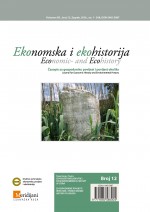Uvjetovanost privrede Požeške županije s fenomenom Dilja u 19. st.
Conditionality of the Požega County Economy by the Dilj Phenomenon in the 19th Century
Author(s): Krešimir ŠkuljevićSubject(s): Agriculture, Regional Geography, Economic history, 19th Century, Financial Markets, Socio-Economic Research
Published by: Društvo za hrvatsku ekonomsku povijest i ekohistoriju - Izdavačka kuća Meridijani
Keywords: Dilj; Požega County; second half of the 19th century; economy; agriculture;
Summary/Abstract: At the core of this paper is Dilj, and consequently the study of all the peculiarities arising from its relief characteristics. The emphasis is on the economic characteristics of the population that lived in the area. Use of numerical indicators and analysis of conclusions revealed the things that led to the peculiarities of life in this area. The area allowed addressing a broad spectrum of economic and agricultural activities, and the said diversification has prevented competition in major markets which is why these products were sold at local fairs. The emphasis in the chronological sense is on the second half of the 19th century. Micro approach and analytical processing of archival material at the State Archives in Slavonski Brod and publications relating to South Dilj led to conclusions that clearly show that the size of the population in the villages on the mountain was less than those that were located on the very edge of the mountain, and the level of homogeneity of the population was greater, which is also a consequence of a certain traffic isolation. Among the published literature the highest value was in literary and educational works of popular expression, by Julij Kempf, Đuro Pilar, Vjekoslav Klaić and Ignjata Brlić. Geological analysis indicates the use of resources of the mountain itself, mostly for personal use, primarily coal and gravel. Along the Granica (“Border”) there was a considerable exploitation of forests. Policy of administrative structures, the regime and the Church representatives, was also mindful of relief specificity which is why administrative municipalities, arms stations and parishes are being established, which were territorially, almost without exception, completely covering the relief area of the mountain. Another confirmation of ethnographic specificity was the existence of an arms station in Odvorci that affirmed the animosity of the population in the highlands to the novelties that came with the integration of Granica and Provincijal.
Journal: Ekonomska i ekohistorija - Časopis za gospodarsku povijest i povijest okoliša
- Issue Year: 2016
- Issue No: 12
- Page Range: 173-185
- Page Count: 13
- Language: Croatian

